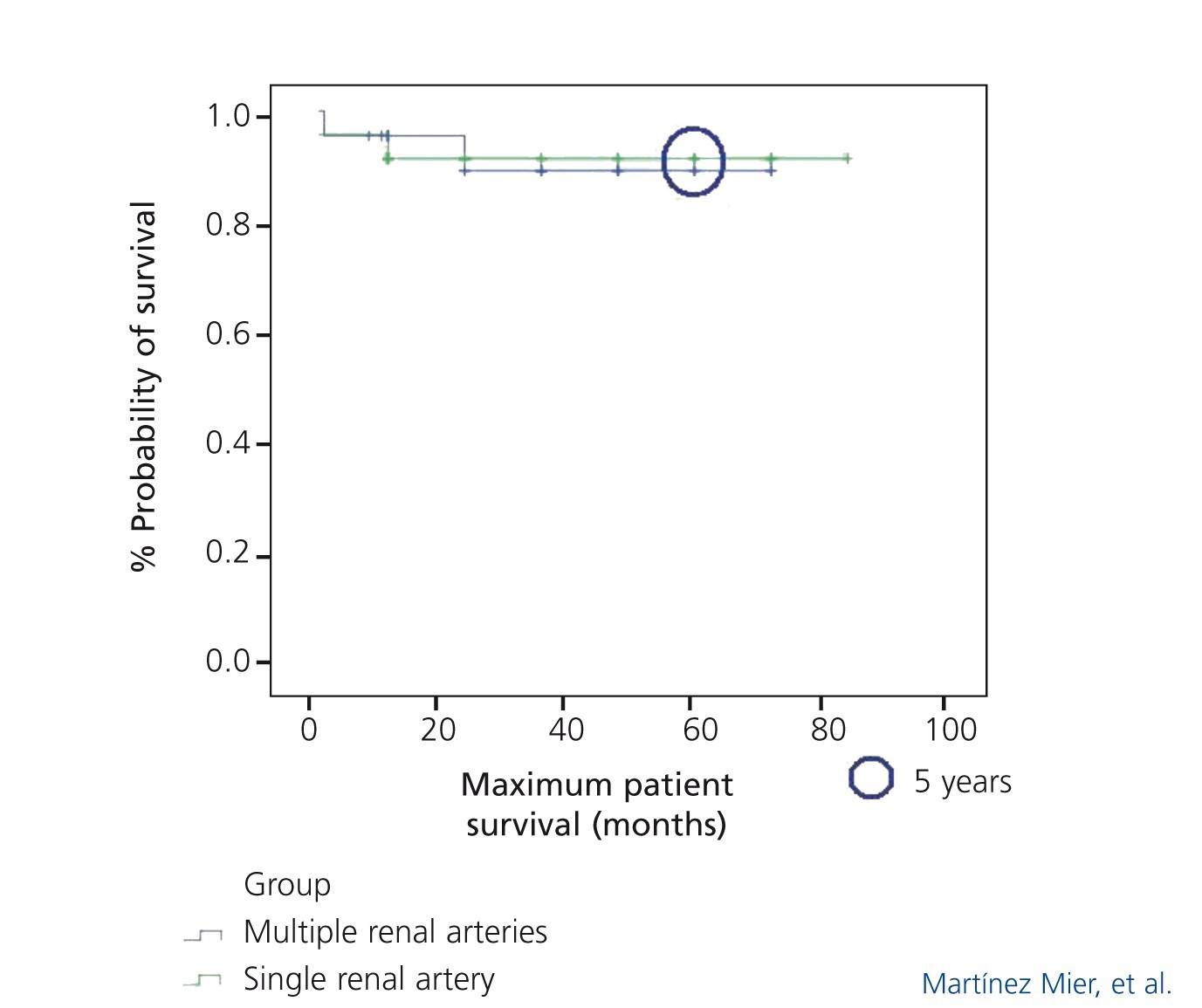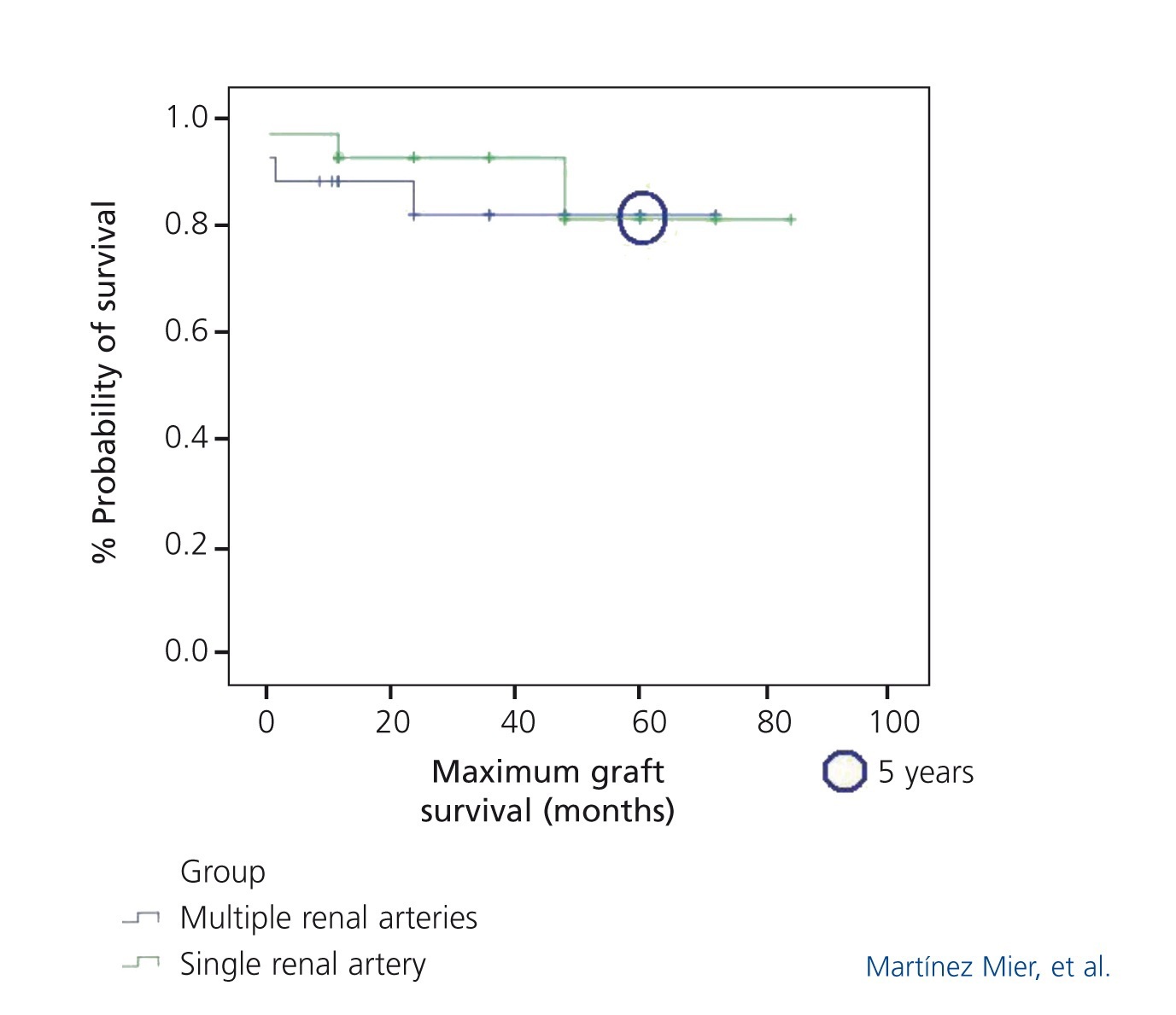To the Editor:
Many of the challenges presented by the surgical procedure of renal transplants are the result of anatomical variations, such as multiple renal arteries (MRA), which are present in 12%-30% of all transplanted kidneys.1-5 The surgical evaluation of live donors facilitates a determination of kidney anatomy in order to establish the safety of the nephrectomy, the most appropriate surgical technique to use, and the length of the blood vessels that will be used. Complex renal vascularisation continues to present a problem that can affect the prognosis of the transplant.2 The first studies involving this issue considered kidneys with MRA to be a contraindication due to the possible increase in vascular complications (stenosis of the renal artery or thrombosis and bleeding),4,5 although currently, the use of these kidneys is more widely accepted.3
We performed a retrospective analysis of 216 cases recorded over the course of 7 years; of these, 23 patients (10.6%) had MRA as compared to a control group (n=23) with single renal arteries (SRA). The mean patient age in the SRA group was 34±10.3 years (range: 18-52 years), whereas the mean age in the MRA group was 35±10.7 years (range: 17-51 years). The majority of patients were male in both groups (SRA: 82.6%, n=19; MRA: 82.6%; n=19). Mean body mass index (BMI) in the SRA group was 25.08±3.85kg/m2 (range: 19.74-36.94kg/m2), and the mean BMI in the MRA group was 25.05±4.34kg/m2 (range: 19.07±36.7kg/m2). The mean time on dialysis in the SRA group was 24±13.56 months (range: 3-78 months), and the mean time on dialysis in the MRA group was 26.2±19.21 months (range: 0-60 months), with no significant differences between groups. The majority of organ donors in the MRA group were male (n=15; 65.2%), whereas the majority of organ donors in the SRA group were female (n=17; 73.9%). The mean donor age in the MRA group was 35.7±9.5 years (range: 21-57 years), and the mean donor age in the SRA group was 36.1±10.1 years (range: 18-52 years). All nephrectomies form live donors were performed using open surgical procedures. Glomerulonephritis was the most commonly observed aetiology in the SRA group (54.5%; n=12), and aetiology of an unknown origin was most commonly observed among patients in the MRA group (54.5%; n=12).
In 2 non-heart beating donors with MRA, a Carrel patch was used on the external iliac artery of the recipient. In live donors, 20 kidneys (95.2%) had 2 renal arteries; 17 (73.9%) underwent a termino-lateral anastomosis between the two arteries. In 3 cases (13%), a double-barrel anastomosis was performed between the 2 renal arteries with a single anastomosis of the iliac artery in the recipient. One patient (4.3%) with MRA had 3 renal arteries, which were managed using 2 anastomoses with the recipient. In the SRA group, non-heart beating donated kidneys (n=2; 8.7%) were grafted using a Carrel patch, and kidneys from live donors (n=21; 91.3%) were joined to the external iliac artery using the traditional approach. We used induction therapy with basiliximab in 73% of SRA cases and in 56% of MRA cases. The most frequently used calcineurin inhibitor in both groups was cyclosporine (n=15; 65.2% in SRA vs n=14; 60.9% in MRA).
In the SRA group, the most frequently observed complication was surgical wound infection (8.7%; n=2) and one patient developed a ureterovesical stenosis. Urological complications (two urine leaks and one patient with reflux) were more common in the MRA group, as was delayed graft function (n=3; 13.6%). The total rate of complications in the SRA group was 13% (n=3) and the rate of complications in the MRA group was 30.4% (n=7). There were no vascular complications (thrombosis, bleeding, and stenosis) in either group. One case of lymphocele was produced in both groups.
The comparison of serum creatinine levels (mg/dl) was not statistically significant after 1 year (SRA: 1.5±0.5 vs MRA: 1.4±0.4), 3 years (SRA: 1.45±0.21 vs MRA: 1.27±0.28), or 5 years (SRA: 1.46±0.39 vs MRA: 1.3±0.25), and the same occurred for creatinine clearance rate as calculated using the Cockcroft-Gault formula (ml/min) after 1 year (SRA: 68±18 vs MRA: 70±16), after 3 years (SRA: 74±14 vs MRA: 74±9) or after 5 years (SRA: 65±17 vs MRA: 65±13). In the SRA group, 7 patients (30.4%) were no longer hypertensive after transplantation, and in the MRA group, 10 patients (43.4%) were no longer hypertensive. As a measure against post-transplantation hypertension, 7 patients in the SRA group (31.8%) and 4 patients in the MRA group (19%) were prescribed 2 different medications (P-value: non-significant). There were no significant differences in terms of patient survival between the two groups (Figure 1). Figure 2 compares graft survival based on the number of renal arteries, with 60 months of follow-up for both groups.
Our results show that post-transplant hypertension and complications associated with kidney transplantation do not differ between patients who receive kidneys from MRA donors and those who receive kidneys from SRA donors, with no effects on graft or patient survival. The existence of MRA and the use of bench procedure surgical techniques are no longer contraindications, especially when kidneys are provided by living donors.
Conflicts of interest
The authors state that they have no potential conflicts of interest related to the contents of this article.
Figure 1. Maximum survival of patients receiving kidney transplants arranged by the number of renal arteries
Figure 2. Survival of kidney grafts arranged by number of renal arteries










